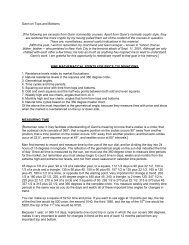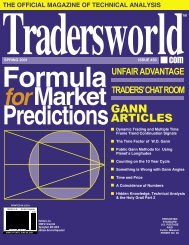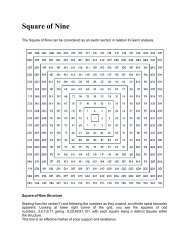Fibonacci and Gann Applications in Financial Markets
Fibonacci and Gann Applications in Financial Markets
Fibonacci and Gann Applications in Financial Markets
Create successful ePaper yourself
Turn your PDF publications into a flip-book with our unique Google optimized e-Paper software.
186 <strong>Fibonacci</strong> <strong>and</strong> <strong>Gann</strong> <strong>Applications</strong> <strong>in</strong> F<strong>in</strong>ancial <strong>Markets</strong><br />
he composed it <strong>in</strong> the follow<strong>in</strong>g way <strong>and</strong> out of the follow<strong>in</strong>g constituents;<br />
From the <strong>in</strong>divisible, eternally unchang<strong>in</strong>g Existence [Essence] <strong>and</strong> the<br />
divisible, chang<strong>in</strong>g Existence of the physical world he mixed a third k<strong>in</strong>d<br />
of existence <strong>in</strong>termediate between them: aga<strong>in</strong> with the Same <strong>and</strong> the Different<br />
he made, <strong>in</strong> the same way, compounds <strong>in</strong>termediate between their<br />
<strong>in</strong>divisible element <strong>and</strong> their physical <strong>and</strong> divisible element: <strong>and</strong> tak<strong>in</strong>g<br />
these three components he mixed them <strong>in</strong>to a s<strong>in</strong>gle unity, forc<strong>in</strong>g the Different,<br />
which was by nature allergic to mixture, <strong>in</strong>to union with the Same,<br />
<strong>and</strong> mix<strong>in</strong>g both with Existence. Hav<strong>in</strong>g thus made a s<strong>in</strong>gle whole of these<br />
three, he went on to make appropriate subdivisions, each conta<strong>in</strong><strong>in</strong>g a mixture<br />
of the Same, <strong>and</strong> Different, <strong>and</strong> Existence. He began the division as<br />
follows. He first marked off a section of the whole, <strong>and</strong> then another twice<br />
the size of the first; next a third, half as much aga<strong>in</strong> as the second <strong>and</strong> three<br />
times the first, a fourth twice the size of the second, a fifth three times the<br />
third, a sixth eight times the first, a seventh twenty-seven times the first.<br />
This results <strong>in</strong> the follow<strong>in</strong>g progression: 1, 2, 3, 4, 9, 8 <strong>and</strong> 27. It is <strong>in</strong>terest<strong>in</strong>g that<br />
repeat<strong>in</strong>g the above rules from stage 2 onwards to extend the series gives the follow<strong>in</strong>g:<br />
54, 81, 108, 243, 216, 729, 1458, 2187, ...<br />
Tak<strong>in</strong>g the relationships of the result<strong>in</strong>g series <strong>in</strong> a similar way to the <strong>Fibonacci</strong><br />
series, results <strong>in</strong> not a s<strong>in</strong>gle limit but six f<strong>in</strong>ite values:<br />
For the relationship n � 1:n,<br />
29.6%, 44.4%, 50.0%, 66.7%, 75.0% <strong>and</strong> 112.5%<br />
14.8%, 33.3%, 50.0%<br />
are obta<strong>in</strong>ed, while for the relationship n � 2:n <strong>and</strong> for the relationship n � 3:n the<br />
follow<strong>in</strong>g are obta<strong>in</strong>ed<br />
9.9%, 14.8%, 16.7%, 22.2%, 25.0%, 37.5%<br />
From work <strong>in</strong> previous chapters, some of these values are already known to be<br />
important <strong>in</strong> <strong>Fibonacci</strong> <strong>and</strong> or <strong>Gann</strong> theory, so can be dismissed at this stage. This<br />
leaves 9.9%, 14.8%, 16.7%, 22.2%, 29.6%, 37.5%, 44.4% <strong>and</strong> 112.5% to be tested.<br />
In this example of the ten-year Bund yield (Figure 10.12), the extremes of the<br />
retracement are set at the high <strong>and</strong> low. Behaviour s<strong>in</strong>ce the low <strong>in</strong> June 2003 has






